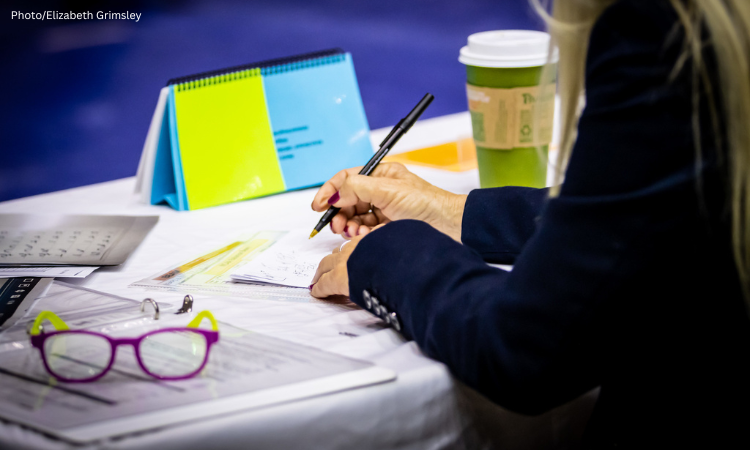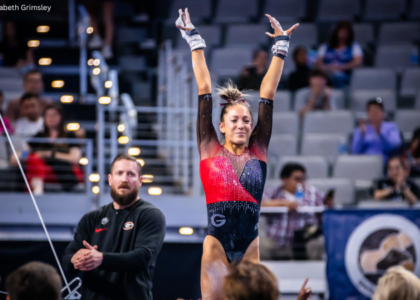This month, we had 22 perfect 10s—excluding those that will inevitably be scored at regionals—but as fans, athletes, commentators, and seemingly everyone other than the judging panel has acknowledged, not all 10.0s are created, or distributed, equally. Here I’ll break down the deductions I saw when watching the videos in real time, and rank the 10.0 from one to five stars. As a reminder, here’s my rating scale:
⭐ This was clearly not a 10.0 routine (but still very good!)
⭐⭐ There was definitely a deduction there, but maybe the judges blinked?
⭐⭐⭐ 10.0 vibes, but not actually perfect
⭐⭐⭐⭐ It was a “college 10”
⭐⭐⭐⭐⭐ 100% a perfect routine
Vault
Olivia Trautman, Oklahoma (March 3)
Deductions
Leg Separation (-0.050)
Arm bend (-0.050)
Shoulder angle (-0.050)
Leg separation (-0.050)
In real time, the only deduction I saw from the camera angle was the leg separation in post flight and the shoulder angle on the table. Slowing it down, I noticed the arm bend on the table, which may or may not have been visible from the judge’s perspective. Her landing was solid and well controlled, with great height, distance, and dynamics. However, I do think it’s realistic to expect that one of the two judges on the panel would have seen at least one of these deductions.
Rating: ⭐⭐⭐
Nikki Smith, Michigan State (March 5)
Deductions
Crossed legs (-0.050)
Squat on landing (-0.050 to 0.100)
Smith has had a phenomenal, breakout year at MSU, including this beautiful Yurchenko one and a half. However, she lands in a rather deep squat with her weight a bit back in her heels. She uses her legs and arms to keep her weight forward and not step back, but the fight for the stick makes the deep squat position on the landing more visible. According to the code of points, a greater-than-45-degree knee bend on a landing should be a deduction. On her landing, she’s at about 90 degrees, which is a one-tenth deduction.
Rating: ⭐⭐⭐
Haleigh Bryant, LSU (March 10)
Deductions
Flexed feet (-0.100)
Hop on landing (-0.050)
Haleigh is a phenomenal vaulter, but I definitely saw her feet flex well in advance of preparing to land on the mat, and she had a clear hop backward on the landing. She is absolutely capable of a five-star 10.0 on this event, but this vault was not it.
Rating: ⭐
Katherine LeVasseur, Oklahoma (March 12)
Deductions
I withdraw my previous comment about her distance on last month’s 10.0 breakdown and attribute it to the camera angle. This was a great vault. Her technique seems to be to finish the twist as late as possible, presumably so she can spot the landing. On this vault, she just barely finished the twist before landing, which you can tell because her left leg took the majority of the impact on the landing as she came around on the last half twist. However, there is no deduction for late completion of turns for flipping vaults, and she did fully complete the twist, making this a true 10.0 vault.
Rating: ⭐⭐⭐⭐⭐
Bars
Jori Jackard, Michigan State (March 5)
Deductions
This was a beautifully executed bar routine by Jackard, and MSU’s first ever 10.0 on bars. It’s fitting that it should be a true five-star 10.0! I noticed she overturned her shoulders a bit on her giant half, but I can’t think of a deduction that would apply, even though it was noticeable.
Rating: ⭐⭐⭐⭐⭐
Jordan Chiles, UCLA (March 5)
Deductions
Bent arms in support (-0.050)
Chiles has scored 9.975 five times this season on bars, and it was only a matter of time before two of those “team 10.0” judges got on the same panel. For me, I’m still on “team 9.950” for this routine solely for her arm bend in her giants, although this is not always deducted by NCAA judges. Chiles also bends her arms when she shifts her wrists on her kip, but I don’t think it’s a deduction since by the time she is in support, her arms are straight. Although not a true 10 in my opinion, she definitely hit the mark for an NCAA 10.0 and finally got her bars 10.0 in 2023 after a long string of 9.975s.
Rating: ⭐⭐⭐⭐
Haleigh Bryant, LSU (March 10)
Deductions
Leg separation (-0.050)
Flexed feet (-0.050)
Failure to join feet on landing (-0.050)
Bryant hit a beautiful bar routine, but honestly, it’s nearly impossible to do this double front half out without deductions. It’s hard to tell how much of the leg separation (or flexed feet) the judges could see from their side angle, but they should have been able to see something. However, the automatic reason this wasn’t a 10.0 for me was that she didn’t close her feet on her landing, which is a flat and automatic half-tenth deduction.
Rating: ⭐⭐
Jordan Chiles, UCLA (March 11)
Deductions
Bent arms (-0.050)
This routine looks exactly the same as her other 10, right down to bent arms on her giant swing.
Rating: ⭐⭐⭐⭐
Trinity Thomas, Florida (March 18)
Deductions
Leg Separation (-0.050)
Arm bend (-0.050) on each giant swing
This was a beautiful bar set from Thomas! She had a small leg separation on her backswing, that looks like it was visible from the side angle on both sides. I’ve also been told that leg separation deductions are even easier to see on a podium, which also tracks with a view on the left, where the camera is closer to the perspective of the judges. So while normally I don’t consider these leg separation deductions since it’s hard for the judges to see them, in this case it was visible and should have been a deduction. She also bends her arms slightly on each of her giant swings into her dismount, which is also hard to see from the side but not impossible, especially if you are looking for it.
Rating: ⭐⭐⭐
Beam
Luisa Blanco, Alabama (March 3)
Deductions
Bent leg (-0.050)
This routine is my favorite Blanco 10.0 so far. She does have a bent leg on her front aerial, but otherwise it was absolutely solid. Her leaps are exquisite, her dismount was a legitimately stuck landing, and her series was rock solid. Definitely a college 10.
Rating: ⭐⭐⭐⭐
Cristal Isa, Utah (March 3)
Deductions
Bent arms (-0.050)
Body position (-0.050)
Isa performed a beautiful beam routine at Utah’s senior night with a couple very minor errors. Although deductions in the code, these aren’t routinely applied for NCAA routines, so this is definitely a college 10.0.
Rating: ⭐⭐⭐⭐
Jade Carey, Oregon State (March 4)
Deductions
Bent arms (-0.050)
Rhythm (-0.050)
Carey performed a beautifully stuck beam routine, but the overall tone of her whole routine is very careful. She takes her time to set up each of her skills and toes the line between connecting and breaking her leap connection here, as well as her front aerial to straddle jump. She continues to move forward throughout the connection and does not have any balance errors, although the connection is very slow. If you compare this to Maile O’Keefe’s (hit) switch leap to split leap, or Reagan Smith’s straddle half to back handspring swing down, you can see why a slow and careful connection like this should get a rhythm deduction to award the aggressive and seamless connections that other competitors are attempting and completing.
Rating: ⭐⭐⭐
Jessica Hutchinson, Denver (March 5)
Deductions
Balance error (-0.050)
Broken connection?
Watch her leap connection carefully. Do you see the small adjustments she makes to her front foot between her switch leap and her split jump? It’s so minor and quick that I can see why the judges did not break this connection, but technically that adjustment should break her leap series. That would technically make her start from a 9.700, as she would also lose a tenth in bonus in addition to the two-tenth penalty for missing a special requirement. Although she did a great job covering her balance error after her split jump, her lower body turns to the side and her left arm drops to save her landing. Even if the judges missed the foot adjustment in the leap series, the landing adjustment on the split jump was noticeable.
Rating: ⭐⭐
Mya Lauzon, California (March 12)
Deductions
Bent arms (-0.050) on each back handspring
Crossed legs (-0.050)
Movement to maintain balance (-0.050)
I absolutely love the choreography, originality, and flexibility that Lauzon shows at the beginning of this routine, and the natural set up for the wolf turn is hard to do well. She has some soft elbows in both of her back handsprings on beam, but this is not a deduction often applied in NCAA. On her dismount, the crossed legs are hard to see on the film, but the landing error is clear, as she goes up on her toes to fight for the stick on her double full. If the landing were a little more definitive, this would have been a four-star 10.0 from me.
Rating: ⭐⭐⭐
Abby Heiskell, Michigan (March 18)
Deductions
Rhythm (-0.050)
Hop on landing (-0.050)
While I am personally not a fan of cat leaps unless both legs are fully turned out, I checked the code of points, and apparently both techniques of having the legs in turnout or parallel are acceptable. What is less clear is if you can do one leg in turnout, and one leg in parallel, as Heiskell does in this routine. I’m always willing to give the gymnast the benefit of the doubt, so I wouldn’t take anything on her cat leap. However, my general rule is if I have any doubts as to whether or not something is connected, I apply a rhythm deduction. Like Carey, Heiskell takes her time to set up her side aerial. She is perfectly in control of her cat leap landing but could be quicker in the connection. Ideally, the series should flow as if she were on a line on the floor. Heiskell also hops her feet together and slightly backward immediately following her landing, which should have been a deduction as she did not show a controlled stick and moved her left foot. However, this routine definitely had 10.0 vibes in front of a home crowd.
Rating: ⭐⭐⭐
Ragan Smith, Oklahoma (March 18)
Deductions
Bent arms (-0.050)
Flexed foot (-0.050)
Balance error (-0.050)
Bent arms (-0.050)
Ragan Smith bends her arms on both of her back handsprings (in her acro series and before her dismount), and her second foot is flexed on her layout step-out throughout the duration of the skill. You can also see she’s a little off to her right (our left), but adjusts quickly. This routine is a perfect example of why judges feel pressured not to take all these small deductions because based on my assessment, this stuck beam routine should have been a 9.800. If you picture a 9.800 beam routine, though, usually it has a very noticeable balance error and a significant step on the landing and isn’t a stuck routine from the top team in the country and one of the top beam-workers. However, it’s important to remember that even those that can be perfect are not always perfect (which is 100% fine!), and athletes should always be scored on their performance that day, not their capabilities or previous accomplishments.
Rating: ⭐⭐
Floor
eMjae Frazier, California (March 3)
Deductions
Leg separation (-0.050)
Pike down (-0.050)
Precision of turn (-0.050)
This was a great routine from Frazier on floor, but she did have some leg separation on her double layout and a pike down. She also overturned her switch half and under-turned her split half. It’s clever to add the third jump to the series as it makes it much harder to asses the degree of turn in this pass, especially since she is also not leaping square to the corner or the side of the floor. Although the pike down and dance pass deductions were more subtle, the leg separation on the double layout was noticeable and should have been deducted.
Rating: ⭐⭐⭐
Halle Remlinger, Minnesota (March 4)
Deductions
Incomplete turn (up to -0.200)
Remlinger, like her teammate Mya Hooten, has gorgeous tumbling and a beautiful switch side quarter straddle three-quarter instead of a switch side straddle full. Because her leaps are parallel to the side of the floor, it’s very easy to see the over turn of the first skill and under turn of the second. Technically the judges could deduct both (which would be up to four tenths in total), but that’s not commonly done (or ever done) in NCAA judging. If this deduction is taken at all, it is usually only half a tenth, even though being fully a quarter turn off should be two tenths each time.
Rating: ⭐⭐⭐
Mya Hooten, Minnesota (March 4)
Deductions
Incomplete turn (up to -0.200)
Movement to maintain balance (-0.050)
I love Hooten’s floor routine. The energy, the power, and the control that she has on her tumbling is impressive. But in every single floor routine I’ve seen from her she always makes the same error on her leap pass, so she would never get a 10.0 from me until she improves the precision of the rotation of her leap pass. She also had a small balance error after her double back where she leans to her left in this routine, which also should have been a deduction.
Rating: ⭐⭐
Lynnzee Brown, Denver (March 5)
Deductions
Body posture on landing (-0.050)
Switch leap half (C)
Leg bend (-0.050)
Brown finished her regular season home career at Denver with a show-stopping floor routine. She had a couple minor execution errors, but the atmosphere in the arena was more than enough to erase them from the judges’ memories. If the judges wanted to be very picky, they could downgrade her switch half to a B because she never lifts an extended leg prior to the switch, but I have only ever seen FIG judges be that picky on leap passes, and it’s hard to be sure in real time.
Rating: ⭐⭐⭐⭐
Haleigh Bryant, LSU (March 10)
Deductions
Front one and a half twist (D)
Leg separation (-0.050)
This was the best floor routine I’ve seen Bryant compete all year. Her dance pass, landings, and tumbling were all beautifully executed and well controlled. She had some leg separation in her double front (also known as a “cowboy”), but generally in NCAA and level 10, judges allow around a shoulder’s width of knee separation in double flipping front tucks as it decreases the risk of injury and is anatomically a better position. While I didn’t deduct for that, she did have some loose legs in her Rudi. Otherwise, this was a flawless routine.
Rating: ⭐⭐⭐⭐
Trinity Thomas, Florida (March 18)
Deductions
I’ve heard some feedback that I can be a little picky on some deductions, like a pike down in a double layout. The reason why? Gymnastics doesn’t have “extra credit” for really good execution, like figure skating does. You can’t give Thomas extra credit for keeping her legs together, her body straight, and landing with her chest up and in control on her double layout. The only way judges can separate the good from the extraordinary is by taking a small deduction each time something is not perfect. Perfection should be rewarded with a perfect 10.0, and “close enough” does a disservice to those that are able to be perfect on that day. In this case, and on this day, Trinity Thomas was perfect.
Rating: ⭐⭐⭐⭐⭐
READ THIS NEXT: Judge’s Inquiry: Breaking Down February’s Perfect 10s Part 1
Article by Rhiannon Franck
Rhiannon Franck is a former national-rated NAWGJ women’s gymnastics judge with over 15 years of USAG judging experience and nine seasons judging NCAA gymnastics. Outside of gymnastics, Franck works at a university as a nursing professor and loves to travel. You can follow her on Instagram and Twitter.
Like what you see? Consider donating to support our efforts throughout the year!





Just wanted to point out Abby Heiskell’s 10.0 beam was not in front of a home crowd, it was in Iowa at Big Tens no less.